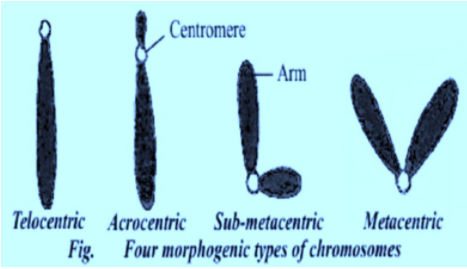Answer
395.7k+ views
Hint: During metaphase, chromosomes are stretched as they are separated due to the forces exerted by the spindle fibres. While being dragged towards the daughter nucleus, various chromosomes appear to have different shapes.
Complete answer:
The chromosome is divided into two sections or ‘arms' at a constriction point known as the centromere. The centromere is the position of DNA that acts as a link between the two sister chromatids. The characteristic shape of the chromosome is given by the position of the centromere on each chromosome. If the centromere is present slightly near the centre, the chromosome arms appear unequal and hence look like the shape of the alphabet ‘L’ during metaphase.

Additional Information:
On the basis of how the chromosomes appear at the metaphase of cell division, chromosomes are divided into 4 main types. Out of which sub-metacentric is as explained above. The remaining three types are -
Metacentric: The centromere is present almost exactly at the centre. The two arms seem almost of the same length. We can also say that the centromere is located in the middle of the complete structure. These chromosomes appear in the shape of alphabet ‘V’ during metaphase.
Acrocentric: The centromere is seen almost towards the end region. The term “acro” in Greek relates to “peak”. Thus, the name acrocentric refers to the type where the centromere is near the terminal region. These chromosomes appear in the shape of the alphabet ‘J’ during metaphase.
Telocentric: The centromere is present at the extreme end. That is the centromere is present in the telomeric region. Hence the name telocentric. However, these telocentric chromosomes are not found in humans. These chromosomes appear in the shape of the alphabet ‘i’ during metaphase.
So, the correct answer is Sub-metacentric i.e option (d).
Note: Some chromosomes also have secondary constriction. These chromosomes are called SAT -chromosomes or marker chromosomes. Some of these secondary constrictions are involved in the formation of nucleoli.
Complete answer:
The chromosome is divided into two sections or ‘arms' at a constriction point known as the centromere. The centromere is the position of DNA that acts as a link between the two sister chromatids. The characteristic shape of the chromosome is given by the position of the centromere on each chromosome. If the centromere is present slightly near the centre, the chromosome arms appear unequal and hence look like the shape of the alphabet ‘L’ during metaphase.

Additional Information:
On the basis of how the chromosomes appear at the metaphase of cell division, chromosomes are divided into 4 main types. Out of which sub-metacentric is as explained above. The remaining three types are -
Metacentric: The centromere is present almost exactly at the centre. The two arms seem almost of the same length. We can also say that the centromere is located in the middle of the complete structure. These chromosomes appear in the shape of alphabet ‘V’ during metaphase.
Acrocentric: The centromere is seen almost towards the end region. The term “acro” in Greek relates to “peak”. Thus, the name acrocentric refers to the type where the centromere is near the terminal region. These chromosomes appear in the shape of the alphabet ‘J’ during metaphase.
Telocentric: The centromere is present at the extreme end. That is the centromere is present in the telomeric region. Hence the name telocentric. However, these telocentric chromosomes are not found in humans. These chromosomes appear in the shape of the alphabet ‘i’ during metaphase.
So, the correct answer is Sub-metacentric i.e option (d).
Note: Some chromosomes also have secondary constriction. These chromosomes are called SAT -chromosomes or marker chromosomes. Some of these secondary constrictions are involved in the formation of nucleoli.
Recently Updated Pages
How do you arrange NH4 + BF3 H2O C2H2 in increasing class 11 chemistry CBSE

Is H mCT and q mCT the same thing If so which is more class 11 chemistry CBSE

What are the possible quantum number for the last outermost class 11 chemistry CBSE

Is C2 paramagnetic or diamagnetic class 11 chemistry CBSE

What happens when entropy reaches maximum class 11 chemistry JEE_Main

Calculate the volume occupied by 88 gram of CO2 at class 11 chemistry CBSE

Trending doubts
Difference between Prokaryotic cell and Eukaryotic class 11 biology CBSE

Fill the blanks with the suitable prepositions 1 The class 9 english CBSE

Two charges are placed at a certain distance apart class 12 physics CBSE

Difference Between Plant Cell and Animal Cell

What organs are located on the left side of your body class 11 biology CBSE

Change the following sentences into negative and interrogative class 10 english CBSE

The planet nearest to earth is A Mercury B Venus C class 6 social science CBSE

The Equation xxx + 2 is Satisfied when x is Equal to Class 10 Maths

What is BLO What is the full form of BLO class 8 social science CBSE



